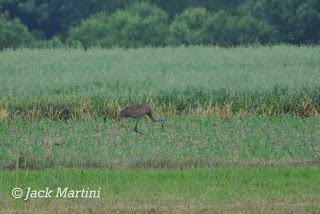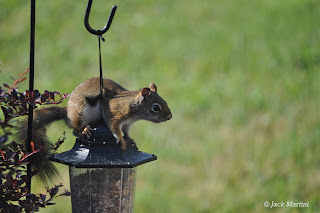The banding crew bumming around at the house. That's me in the camo hat, I'm 95% positive I was sleeping here, I had worked 8-4 that day!
Photo by Mrs. R.
Well, 6:00 am came pretty early, especially when you are spending the night in a sleeping bag on a cement floor! There was a shortage of beds and couches, so being the gentleman that I am, I chose to leave the beds to the ladies. Truth is I could have slept on a bed of cacti that night!! Anyhow, we met Dave B. around 6:30 that morning. Mr. B. is a known scientist/bander, who was leading the gang. We arrived to where we would leave the vehicles, and after a quick briefing began our short yet enjoyable trek through the lush Allegheny National Forest.
Lugging the gear up the trail to our site.
Photo by Mrs. R.
When we arrived to our "staging area", Mr. B. gave us a quick rundown of the process. We would set the net, bait, and build a blind where two of us would sit and wait for the Goshawks to take our bait under the nest, while the rest of the crew waited at a staging area. We wanted the main group to stay far away from the site of the Goshawk nest as not to spook the birds.
The crew, getting our game plan lecture from Mr. B.
Photo by Mrs. R.
The crew, getting our game plan lecture from Mr. B.
Photo by Mrs. R.
We left the staging area carrying the gear for the net and equipment to build the blind. Mr. B. had told us that the 3 chicks in the nest were too old in order to capture. They were young enough that they had yet to leave the nest, though old enough to fly short distances. In order to band chicks, you must first capture the adults, then climb the nest tree and gather them. These chicks were 36-40 days old, and very able to leave the nest if we were to try to climb the nest tree. One of the chicks actually fledged as soon as we got to the site.
Looking at the Northern Goshawk nest and chicks
Photo by Mrs. R.
I was very excited to see the Goshawk chick, acording to the "Peterson Field Guide to Birds of Eastern and Central North America" this is a scarce species, for which I have no recording sightings.
The Northern Goshawk nest with one of the chicks
The Northern Goshawk nest with one of the chicks
Can you beleive that this big guy is only 36-40 days old!?
After letting us get a good look at the visible chick, along with a few photos, Mr. B. put us to work! Another student Toby N. and I were assigned the duty of setting up a pile of logs to put the bait on as well as help clear brush for the drop net, while others built a blind and also cleared brush. Once the brush was cleared, we began setting up the drop net.
Some of the other volunteers and I clearing brush and setting up the drop net.
Photo by Mrs. R.
Now that the net had been set up, and the blind was built, it was time to set the bait. Bait may not be the best word choice, maybe lure or decoy...? How about helper? Anyhow, once we were ready Mr. B. got out our helper, an injured and unreleasable Great Horned Owl. This owl had been on many banding projects, none of which has caused harm to the owl itself or the birds that it was aiding capture to.
Mr. B. with our helper.
The owl is set on the cunstructed log pile below the nest on the opposite side of the drop net. When the parent goshawks see this natural predator they swoop down from the nest to fend him off, resulting in the defending hawk to hit the net and be safely restrained until volunteers capture and process the bird. So what is the point..? Mark and recapture, or capturing animals, fitting them with a unique band or radio transmitter, and recapturing them, is conducted to study the behavior of that species. Using these methods, we can study migration, population growth, population loss, survivorship, breeding habits, population density, and much much more. Some think that this is harmful for the animal, and puts them in distress. Of course the animal is in distress, but as scientists we keep this in mind. And while practicing these management techniques we try to keep stress to a minimum. Simply by covering the eyes of and being as quiet as possible while handling animals, the stress levels can be kept very low.
Mr. B. giving our helper his instructions.
Our helper sitting on his throne, he held strong for the day!
Photo by Mrs. R.
Mr. B. and the banding crew checking the finishing touches to our site.
Photo by Mrs. R.
After setting up our net site and leaving two members of the group behind to sit in the blind, we returned to our staging area around 9:00 am to wait and hope for good news. While most of the group played cards, I was listening to bird songs and thumbing through my field guides.
The banders playing cards
Photo by Mrs. R.
This is where we spent hours and hours waiting for that call on the radio.
Right around noon Mr. B. sent a volunteer down to the blind to deliver lunch and releive one of the volunteers waiting. Nick from Garret County Maryland came back with some great knowledge in bird song identification. We spent the afternoon discussing bird songs, calls, and he and Mr. B. helped me get a handle on a few species as we sat and listened waiting for the radio call. The call never came, but the volunteers at the blind did with rough news. The female had flown without going after our helper, and the male had yet to show up. So the new plan was for all volunteers to wait at the staging area, while Mr. B. waited far enough from the nest to be undetected, while staying close enough to hear the hawk hit the net. Sometimes things don't go the way that you plan or hope, and by 5:30 pm the majority of the group left the woods that day without getting an up close look at a mature Northern Goshawk, unfortunately I was one of them. I was told by one of the volunteers that they had captured the female parent about an hour and a half after we had left. This bird was captured last year, which also took all day to happen. The male had never showed up, we assumed that he had another territory that he was occupying that day. Though I wasn't there for the recapture of the bird, I spent the day with a group of scientists and science students in the beautiful Allegheny National Forest which made for an extremely relaxing and enjoyable Memorial Day.


















































